
Students will create a compilation of 20 images from the 1960s and explain the significance of each image.
- Subject:
- History
- Material Type:
- Activity/Lab
- Assessment
- Diagram/Illustration
- Date Added:
- 07/14/2017

Students will create a compilation of 20 images from the 1960s and explain the significance of each image.
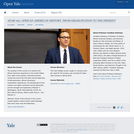
The purpose of this course is to examine the African American experience in the United States from 1863 to the present. Prominent themes include the end of the Civil War and the beginning of Reconstruction; African Americans' urbanization experiences; the development of the modern civil rights movement and its aftermath; and the thought and leadership of Booker T. Washington, Ida B. Wells-Barnett, W.E.B. Du Bois, Marcus Garvey, Martin Luther King Jr., and Malcolm X. WARNING: Some of the lectures in this course contain graphic content and/or adult language that some users may find disturbing.

This course examines the social, cultural, political, and economic history of the United States, from the Civil War to the present. It uses secondary analysis and primary documents, such as court cases, personal accounts, photographs, and films, to examine some of the key issues in the shaping of modern America, including industrialization and urbanization, immigration, the rise of a mass consumer society, the emergence of the US as a global power, and the development of civil rights activism and other major social movements.
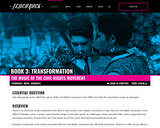
In this lesson, students will examine the history and popularity of "We Shall Overcome" and investigate six additional songs from different musical genres that reveal the impact of the Civil Rights movement. These are: Billie Holiday's "Strange Fruit," a poignant Blues song depicting the horrors of lynching; Bob Dylan's "Oxford Town," a Folk song about protests after the integration of the University of Mississippi; John Coltrane's "Alabama," an instrumental Jazz recording made in response to the September 1963 church bombing in Birmingham, Alabama, that killed four African-American girls; Nina Simone's "Mississippi Goddam," a response to the same church bombing as well as the murder of civil rights activist Medgar Evers in Mississippi; Sam Cooke's "A Change is Gonna Come," a Soul song written after Cooke's arrest for attempting to check in to a whites-only motel in Shreveport, Louisiana; and Odetta's "Oh Freedom," a spiritual that Odetta performed at the 1963 March on Washington.
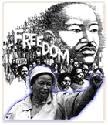
This resource contains some powerpoint slides, google slides, videos, images and worksheets that focus on the civil society protests. It is for specifically designed for Grade 12 learners.
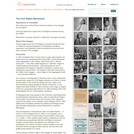
In 1948, President Harry Truman took an early step towards civil rights reform by issuing Executive Order 9981, which eliminated racial segregation in the military. After World War II, African Americans ? then often called Negroes or "coloreds," began to mobilize against discrimination. They demanded an end to segregation and fought for equality in education, housing, and employment opportunities. The images in this topic show that by the 1960s, their struggle ? which began in the segregated South ? had reached California. As a number of photographs in this topic show, many Californians showed their support for Civil Rights activists and victims of racial discrimination in the South by holding marches, rallies, and demonstrations urging equality for African Americans. In one image three white children in San Francisco hold a sign in support of the four young black girls killed in the 1963 bombing of the 16th Street Baptist Church in Birmingham, Alabama. Photographs also show people in San Francisco boycotting Kress and Woolworth's department stores, sites of racial discrimination in the South. Documents shown here include a flyer urging the boycott of the stores; and a Western Union telegram sent in 1963, stating that Civil Rights activists Roy Wilkins and Medgar Evers were arrested attempting to picket Woolworth's in Jackson, Mississippi. Two photographs of memorials for slain civil rights leaders ? a march in honor Medgar Evers in 1963, in Los Angeles, and a memorial in the San Francisco Bay Area for Martin Luther King, Jr., in 1968 ? show racially mixed crowds in attendance. But not all Californians sympathized with the Civil Rights movement. Images of racial hatred and prejudice are reflected in the photograph of an African American woman holding a rock that had been thrown through an office window, and Klu Klux Klan graffiti spray-painted on a home. Various groups formed to fight in the struggle for equal rights. The National Association for the Advancement of Colored People (NAACP), formed in 1909, entered a new phase during this period, leading in the organized struggle for civil rights. An example of how the NAACP communicated about events is reflected in a letter from the Alameda County branch of the NAACP on June 13, 1950, which reported segregation on the Southern Pacific Railroad trains leaving Los Angeles. A flyer promoting the boycott of California grapes exemplifies NAACP support for other rights movements, in this case the United Farm Workers. Other flyers urged Californians to fight sharecropper wages and "Keep Mississippi Out of California." Groups such as the Congress of Racial Equality (CORE) and student groups also protested segregation and incidents of racial discrimination in the South. Several important African American leaders ? including Martin Luther King, Jr., Malcolm X, Thurgood Marshall, and Ralph Abernathy ? all came to California, as documented by photographs included here. Sometimes, the price of fighting for social justice was high. Two images capture events held for leaders in the social justice movement who were assassinated: the 1963 memorial march in Los Angeles for civil rights leader Medgar Evers; and a crowd attending a Martin Luther King, Jr., Memorial Rally in honor of the slain civil rights leader.
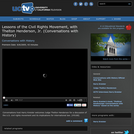
Conversations host Harry Kreisler welcomes Judge Thelton Henderson for a discussion of the U.S. civil rights movement and its implications for international law. (43 min)

Students will learn about the juxtaposition of image and text to define the social and psychological mood of the civil rights movement in the United States.
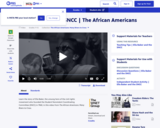
Learn the story of Ella Baker, the unsung hero of the civil rights movement who founded the Student Nonviolent Coordinating Committee (SNCC) in 1960, in this video from The African Americans: Many Rivers to Cross.
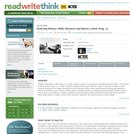
Nikki Giovanni's poem 'The Funeral of Martin Luther King, Jr.' is paired with Dr. King's "I Have a Dream" speech, taking students on a quest through time to the Civil Rights movement.
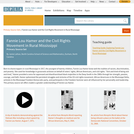
This collection uses primary sources to explore Fannie Lou Hamer and the civil rights movement in rural Mississippi. Digital Public Library of America Primary Source Sets are designed to help students develop their critical thinking skills and draw diverse material from libraries, archives, and museums across the United States. Each set includes an overview, ten to fifteen primary sources, links to related resources, and a teaching guide. These sets were created and reviewed by the teachers on the DPLA's Education Advisory Committee.

This collection uses primary sources to explore The Fire Next Time by James Baldwin. Digital Public Library of America Primary Source Sets are designed to help students develop their critical thinking skills and draw diverse material from libraries, archives, and museums across the United States. Each set includes an overview, ten to fifteen primary sources, links to related resources, and a teaching guide. These sets were created and reviewed by the teachers on the DPLA's Education Advisory Committee.

In this lesson, students will use a primary source—an NBC news report from 1961—to investigate the Freedom Rides. The lesson will also explore segregation in the South and the tenets of nonviolent protest.
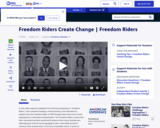
In this video segment adapted from American Experience: "Freedom Riders," view newsreel footage, archival photos, and interviews to explore how the Freedom Rides of 1961 brought about the end of racial segregation in interstate transportation. The Freedom Riders, aware that their nonviolent protest would elicit violence from some Southerners attempting to enforce local segregation laws, were determined to continue their protest even in the face of possible arrest. A series of events involving the U.S. attorney general, a U.S. senator, the governor of Mississippi, and a federal agency put an end to discriminatory practices in public transportation. This initial, unambiguous victory for the Civil Rights Movement paved the way for further progress.
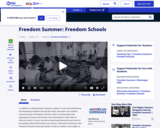
In addition to helping black residents register to vote and establishing the Mississippi Freedom Democratic Party, education was another important goal of Freedom Summer. Years of substandard and segregated schools and libraries had contributed to high rates of illiteracy (which, in turn, had led to disenfranchisement) and a lack of knowledge about black history and culture. Volunteers teaching in the Freedom Schools found that adults as well as children were eager to learn. The experience gave many black people newfound hope that things were about to change.
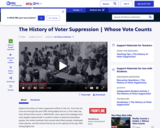
Explore the history of voter suppression efforts in the U.S., from the Jim Crow era through the post-1965 Voting Rights Act era, in this video clip from Whose Vote Counts | FRONTLINE. Learn about the strategies that were legally implemented in southern states to disenfranchise Black people, the violent backlash that ensued when Black people challenged these policies, and the events that led up to the signing of the epic 1965 Voting Rights Act.

In 1965, President Lyndon B. Johnson signed into law the Immigration and Nationality Act which replaced the quota immigration system that had been in existence since the 1920s, with a preference system based on labor skills needed by the United States, and those who had a pre-existing family tie in the country. This lesson will explore past U.S. immigration laws that affected Asian immigration and naturalization, how the Immigration and Nationality Act of 1965 came about because of the Civil Rights Movement, and how the 1965 Act changed the demographics of the country over the next twenty years and beyond.
2021 Social Science Standards Integrated with Ethnic Studies:
Civics and Government: 5.1, 6.4, 7.5, 8.7, 8.8, 8.9
Geography: 5.13
Historical Knowledge: 5.22, 6.20, 6.21, 8.22, 8.25, HS.52, HS.57, HS.58, HS.61, HS.63, HS.64, HS.65
Historical Thinking: 5.24, 7.25, 8.30, 8.31, 8.32
Social Science Analysis: 5.26, 5.27, 6.24, 6.27, 7.29, 8.36, HS.72, HS.73, HS.74, HS.75
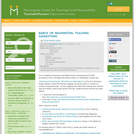
The 50th anniversary of the Civil Rights Movement's 1963 March on Washington is a great teaching opportunity. We offer some helpful resources.
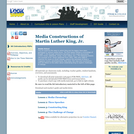
This kit explores the ways in which King and his legacy have been portrayed in various media forms. The first lesson follows a chronology of King's life through interactive decoding of rich media documents (comic books, billboards, songs, music videos, etc.). The following lessons use excerpts of Dr. King's speeches from 1963, 1967 and 1968 to examine his views on social change; explore the portrayal of King in magazine covers, advertisements, Web sites, film clips and monuments; and use letters to the editor about celebrating King to explore challenges to change.

This five-minute video introduces students to the findings of the Kerner commission, a panel of experts President Lyndon Johnson convened to make policy recommendations following the protests, violence and disorder that occurred in over 150 cities in 1967. The commission recommended a series of sweeping changes, including reforms in policing tactics and efforts to reduce urban poverty. But Johnson largely ignored the findings of the study. Useful in helping students make connections between the 1960s and today, the video sets up an engaging class discussion on race, poverty and policing.
Content Advisory: This video includes footage of police violence. This resource contains additional material that may be sensitive for some students. Teachers should exercise discretion in evaluating whether this resource is suitable for their class.